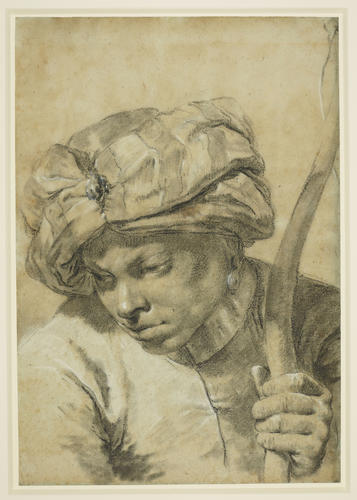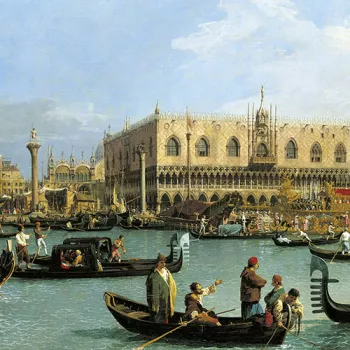An archer in a turbanned headdress c. 1730-40
Black and white chalk on blue paper faded to dull brown | 39.0 x 26.9 cm (sheet of paper) | RCIN 990755

Giovanni Battista Piazzetta (1682-1754)
An archer in a turbanned headdress c. 1730-40

Giovanni Battista Piazzetta (1682-1754)
An archer in a turbanned headdress c. 1730-40


-
A black and white chalk drawing of a young man, holding a bow and wearing a silk turban and jewelled earring.
It is not possible to know the identity of the sitter in this drawing, but it possibly shows a model of North African descent, who has evidently been dressed in 'exotic' costume in the artist's studio. Giovanni Battista Piazzetta produced a great number of these chalk drawings on blue paper of character heads, with one, two and sometimes three heads on the same sheet. Although some of his models have been identified (Piazzetta's wife, son and daughter appear several times), these drawings are not intended as portraits of particular sitters. Instead they are often shown with accompanying attributes, or with particular facial expressions, operating in the tradition of têtes d'expression, or the tronies of Dutch seventeeth century art.
Often the meaning of Piazzetta's drawings is not overt, and they show character types, of priests, philosophers, children and Venetian youths. In this sheet, Piazzetta takes up the trope of a Black sitter dressed in 'exotic' costume, often a turban, commonly seen in Dutch tronies by Rembrandt, Jan Lievens and Gerrit Dou. Although the depiction of the man's features is highly individualistic, he is presented as a timeless fantasy character rather than a real person. Depicting African men as archers was another common trope (see for example, Govaert Flinck, A Young Archer, Wallace Collection, London, or a print after Cornelis Visscher of a Black boy with bow and arrow published in 1650), and was based on widespread misconceptions among writers of the period that Africans hunted with bows and arrows. For centuries Venice had also been seen as western Europe’s principal point of contact with the Near East, and this may have also influenced Piazzetta's depiction of a luxuriously dressed figure in jewels and patterned silks. A drawing with the same sitter is in the Cleveland Museum of Art, though the turban and cloak are of a different form and the figure's expression is here more melancholic.
The drawings were made in two distinct stages: a first application of black chalk, thoroughly worked into the surface of the paper with the fingers or a stump to provide a smoky underlayer; and then sharp strokes of black and white chalks to bring the drawing into focus. There are few reference points for a chronology of Piazzetta’s head drawings: only two are dated, and a couple of self-portraits provide some further guidance (if his apparent age in those drawings is reliable), but the deliberate differences in approach from sheet to sheet mask any natural evolution of style. The date of this drawing can thus be little more than a guess.
Piazzetta's biographers (Albrizzi, Studij di pittura and Dezalier d'Argenville) noted that it was through the sale of these drawings that he was able to sustain his family, and he built up a strong reputation for them. The drawings were always intended to be framed and hung, the consequent exposure to daylight causing the paper to fade from blue to brown. All thirty-six of the Piazzetta heads in the Royal Collection, which were hanging at Buckingham Palace until the early twentieth century, must have been acquired as part of the collection of Consul Joseph Smith in 1762. Many of the Piazzetta heads in Smith's collection were engraved by Cattini in 1754 as the Icones ad vivum expressae.Provenance
Probably among those mentioned in Pietro Guarienti's additions to Orlandi's Abecedario (Venice, 1753), p. 280, 'le teste egregiamente fatte a chiaroscuro sono nella galleria doviziosissima del Signor Giuseppe Smith Console Inglese' and acquired by George III from Consul Joseph Smith in 1762
-
Medium and techniques
Black and white chalk on blue paper faded to dull brown
Measurements
39.0 x 26.9 cm (sheet of paper)
Other number(s)
RL O : Royal Library "O" Number Register – RL O0755Alternative title(s)
The head of a Moor [former title]








